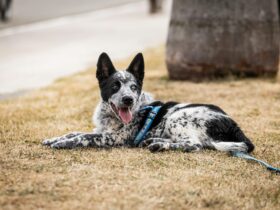Teaching your dog to heel on a leash can transform your walks into enjoyable, controlled experiences. One of the most effective and often overlooked techniques for teaching this behavior is hand targeting. Hand targeting simplifies the process of leash training and helps create a more reliable and engaging heeling experience. In this comprehensive guide, we’ll explore why hand targeting is so effective, how to implement it, and the benefits it offers for both you and your dog.
Understanding Hand Targeting
What is Hand Targeting?
Hand targeting involves training your dog to touch their nose to your hand on cue. This technique utilizes positive reinforcement to guide your dog into various positions and behaviors. When applied to leash training, hand targeting becomes a powerful tool for teaching your dog to maintain a consistent position beside you while walking.
Why Hand Targeting Works
- Clear Communication: Hand targeting provides a clear and simple cue for your dog, helping them understand where you want them to be and what you expect.
- Positive Reinforcement: This method relies on rewards to motivate your dog, making the training process enjoyable and reinforcing desired behaviors.
- Focus and Engagement: Hand targeting captures your dog’s attention and encourages them to stay engaged with you, which is crucial for successful heeling.
Benefits of Using Hand Targeting for Leash Training
1. Improved Focus and Attention
- Increased Engagement: By using your hand as a target, you direct your dog’s attention to you, which helps them stay focused on the task at hand.
- Reduced Distractions: Hand targeting helps minimize distractions by keeping your dog’s focus on you rather than their surroundings.
2. Enhanced Leash Manners
- Consistent Positioning: Hand targeting guides your dog to stay close to your side, promoting proper heeling and reducing the likelihood of pulling or lagging.
- Clear Guidance: This technique provides clear and consistent guidance, helping your dog learn the desired position more quickly.
3. Positive Training Experience
- Motivational Rewards: Hand targeting uses positive reinforcement, such as treats or praise, to reward your dog for their efforts. This makes the training process enjoyable and reinforces good behavior.
- Strengthened Bond: Engaging in hand targeting builds trust and strengthens the bond between you and your dog, creating a more cooperative training experience.
How to Teach Hand Targeting
1. Introduce the Hand Target
- Choose a Cue: Decide on a verbal cue, such as “target” or “touch,” to use when you want your dog to touch their nose to your hand.
- Present Your Hand: Extend your hand towards your dog, keeping it at their nose level. Use a treat to attract their attention to your hand.
2. Encourage the Behavior
- Use a Treat: Hold a treat in your hand to entice your dog to touch their nose to your palm. As soon as they make contact, reward them with the treat and praise.
- Reinforce Repeatedly: Practice this exercise several times in short sessions. Consistently reward your dog for touching your hand to reinforce the behavior.
3. Add a Verbal Cue
- Introduce the Cue: Once your dog is consistently touching your hand, introduce the verbal cue you’ve chosen. Say the cue just before presenting your hand.
- Practice with Cue: Continue practicing with the verbal cue and hand presentation. Reward your dog for responding to the cue and touching your hand.
4. Incorporate Hand Targeting into Leash Training
- Leash Training Basics: Begin by walking with your dog on a leash in a controlled environment. Keep the leash short but not tight, allowing your dog some freedom to move.
- Use Hand Targeting: Hold your hand out to the side of your body while walking. Encourage your dog to touch their nose to your hand to maintain their position beside you. Reward them for staying in position.
Teaching Your Dog to Heel Using Hand Targeting
1. Start with Basic Heeling Position
- Get into Position: Begin by standing with your dog at your side. Use the hand target to guide them into the heel position, where they should be close to your leg.
- Reinforce Position: Once your dog is in the correct position, reward them with a treat and praise. Repeat this process to help them understand the desired position.
2. Practice Walking with Hand Targeting
- Start Walking: Begin walking with your dog while holding out your hand as a target. Encourage your dog to maintain their position beside you by touching their nose to your hand.
- Reinforce Consistency: Reward your dog for staying in the heel position and for touching their nose to your hand as you walk. Continue to practice in different environments to build their reliability.
3. Gradually Increase Difficulty
- Add Distractions: Once your dog is comfortable with basic heeling, introduce mild distractions to help them generalize the behavior. Practice in various locations and situations.
- Extend Duration: Increase the duration of your walks and practice longer sessions of heeling with hand targeting. Reward your dog for maintaining the correct position throughout.
Troubleshooting Common Challenges
1. Lack of Focus
- Increase Motivation: Use high-value treats or toys to maintain your dog’s interest and focus. Ensure that the rewards are appealing and motivating.
- Shorten Sessions: Keep training sessions short and frequent to prevent your dog from becoming bored or distracted. Gradually increase the length as their focus improves.
2. Pulling or Lagging
- Adjust Hand Position: If your dog is pulling or lagging, adjust your hand position to guide them back to the correct position. Use positive reinforcement to reward them for staying close.
- Practice Consistently: Consistent practice and reinforcement are key to addressing pulling or lagging. Keep sessions positive and engaging to encourage good behavior.
3. Overexcitement
- Calm Environment: Practice hand targeting and heeling in a calm environment before introducing higher levels of excitement or distraction.
- Use Calming Techniques: Incorporate calming techniques, such as deep breathing and steady walking, to help your dog remain focused and relaxed.
Tips for Successful Training
1. Be Patient and Consistent
- Consistency: Consistency in your cues, rewards, and hand positioning helps your dog learn and understand what is expected. Stick to a regular training routine.
- Patience: Training takes time, and each dog learns at their own pace. Be patient and give your dog time to grasp the concepts and behaviors.
2. Use Positive Reinforcement
- Reward Frequently: Reward your dog frequently for correct behavior to reinforce their learning and motivation. Use treats, praise, or toys as rewards.
- Avoid Negative Reinforcement: Focus on positive reinforcement rather than negative reinforcement. Positive interactions create a more enjoyable and effective training experience.
3. Engage in Regular Practice
- Daily Training: Incorporate hand targeting and heeling practice into your daily routine. Short, frequent sessions are more effective than long, infrequent ones.
- Varied Environments: Practice in different environments and situations to help your dog generalize the behavior and become reliable in various settings.
Conclusion
Hand targeting is a highly effective technique for teaching your dog to heel on a leash. By using this method, you provide clear guidance and create a positive training experience that enhances your dog’s focus, engagement, and leash manners. With patience, consistency, and positive reinforcement, you can master the art of heeling and enjoy smooth, enjoyable walks with your canine companion. Embrace the power of hand targeting and transform your leash training experience today!
Happy training!











Leave a Reply